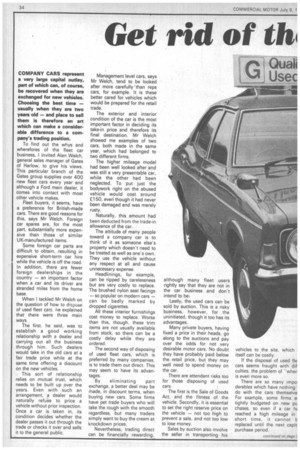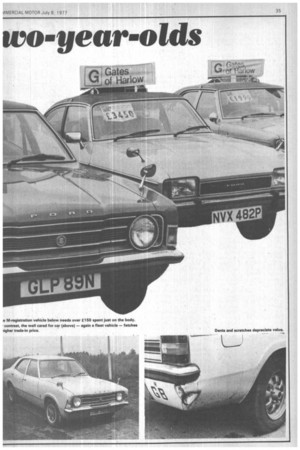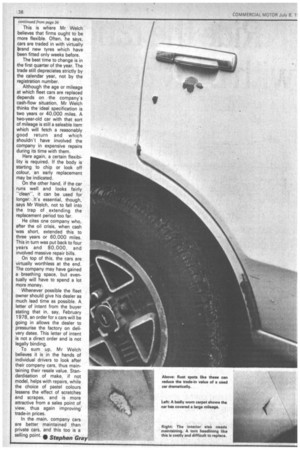Get rid of thi
Page 36

Page 37

Page 38

If you've noticed an error in this article please click here to report it so we can fix it.
we-year-olds
Quail Usec
COMPANY CARS represent a very large capital outlay, part of which can, of course, be recovered when they are exchanged for new vehicles. Choosing the best time — usually when they are two years old — and place to sell them is therefore an art which can make a consider able difference to a company's trading position.
To find out the whys and wherefores of the fleet car business, I invited Alan Welch, general sales manager of Gates of Harlow, to give his views. This particular branch of the Gates group supplies over 400 new fleet cars every year and although a Ford main dealer, it comes into contact with most other vehicle makes.
Fleet buyers, it seems, have a preference for British-made cars. There are good reasons for this, says Mr Welch. Foreign car spares are, for the most part, substantially more expensive than those of similar UK-manufactured items.
Some foreign car parts are difficult to obtain, resulting in expensive short-term car hire while the vehicle is off the road. In addition, there are fewer foreign dealerships in the country — an important factor when a car and its driver are stranded miles from the home base.
When I tackled Mr Welch on the question of how to dispose of used fleet cars. he explained that there were three main ways.
The first, he said, was to establish a good working relationship with a dealer and carrying out all the business through him. Such dealers would take in the old cars at a fair trade price while at the same time offering a discount on the new vehicles.
This sort of relationship relies on mutual trust, which needs to be built up over the years. Even with such an arrangement, a dealer would naturally refuse to price a vehicle without prior inspection. Once a car is taken in, its condition decides whether the dealer passes it out through the trade or checks it over and sells it to the general public. Management level cars, says Mr Welch, tend to be looked after more carefully ' than reps cars, for example. It is these better cared for vehicles which would be prepared for the retail trade.
The exterior and interior condition of the car is the most important factor in deciding its take-in price and therefore its final destination. Mr Welch showed me examples of two cars, both made in the same year, which had belonged to two different firms.
The higher mileage model had been well looked after and was still a very presentable car, while the other had been neglected. To put just the bodywork right on the abused vehicle would cost around Ul 50, even though it had never been damaged and was merely rusty.
Naturally, this amount had been deducted from the trade-in allowance of the car.
The attitude of many people toward a company car is to think of it as someone else's property which doesn't need to be treated as well as one's own. They use the vehicle without any respect at all and cause unnecessary expense.
Headlinings, for example, can be ripped by carelessness but are very costly to replace. The brushed nylon seat facings — so popular on modern cars — can be badly marked by dropped cigarettes.
All these interior furnishings cost money to replace. Worse than this, though, these trim items are not usually available from stock, so there can be a costly delay while they are ordered.
The second way of disposing of used fleet cars, which is preferred by many companies, is to trade them out direct. This may seem to have its advantages.
By eliminating part exchange, a better deal may be Made, in discount terms, when buying new cars. Some firms have pet trade buyers who will take the rough with the smooth regardless, but many traders simply want to buy the cream at knockdown prices.
Nevertheless, trading direct can be financially rewarding, although many fleet users rightly say that they are not in the car business and don't intend to be Lastly, the used cars can be sold by auction. This is a risky business, however, for the uninitiated, though it too has its advantages.
Many private buyers, having fixed a price in their heads, go along to the auctions and pay over the odds for not very desirable motor cars. No doubt they have probably paid below the, retail price, but they may well need to spend money on the car.
There are attendant risks too for those disposing of used cars.
The first is the Sale of Goods Act, and the fitness of the vehicle. Secondly, it is essential to set the right reserve price on the vehicle — not too high to prevent a sale, and not too low to lose money.
Sales by auction also involve the seller in transporting his
vehicles to .the site, which itself can be costly.
If the disposal of used fle cars seems fraught with dif culties, the problem of -wher is even more so.
There are so many 'moo' derables which have nothing • do with the cars themselve For example, some firms al tightly budgeted on new pu chases, so even if a car hi reached a high mileage in short time, it cannot h replaced until the next capit, purchase period. This is where Mr Welch believes that firms ought to be more flexible. Often, he says, cars are traded in with virtually brand new tyres which have been fitted only weeks before.
The best time to change is in -the first quarter of the year. The trade still depreciates strictly by the calendar year, not by the registration number.
Although the age or mileage at which fleet cars are replaced depends on the company's cash-flow situation, Mr Welch thinks the ideal specification is two years or 40,000 miles. A two-year-old car with that sort of mileage is still a saleable item which will fetch a reasonably good return and which shouldn't have involved the company in expensive repairs during its time with them.
Here again, a certain flexibility is required. If the body is starting to chip or look off colour, an early replacement may be indicated.
On the other hand, if the car runs well and looks fairly "clean", it can be used for longer. It's essential, though, says Mr Welch, not to fall into the trap of extending the replacement period too far.
He cites one company who, after the oil crisis, when cash was short, extended this to three years or 60,000 miles. This in turn was put back to four years and 80,000, and involved massive repair bills.
On top of this, the cars are virtually worthless at the end.
The company may have gained a breathing space, but eventually will have to spend a lot more money.
Whenever possible the fleet owner should give his dealer as much lead time as possible. A.
letter of intent from the buyer stating that in, say, February 1978, an order for x cars will be going in allows the dealer to pressurise the factory on delivery dates. This letter of intent is not a direct order and is not legally binding.
To sum up, Mr Welch believes it is in the hands of individual drivers to look after their company cars, thus main taining their resale value. Standardisation of make, if not model, helps with repairs, while the choice of pastel colours lessens the effect of scratches and scrapes, and is more attractive from a sales point of view, thus again improving' trade-in prices.
In the main, company cars are better maintained than private cars, and this too is a selling point. • Stephen Gra




























































































